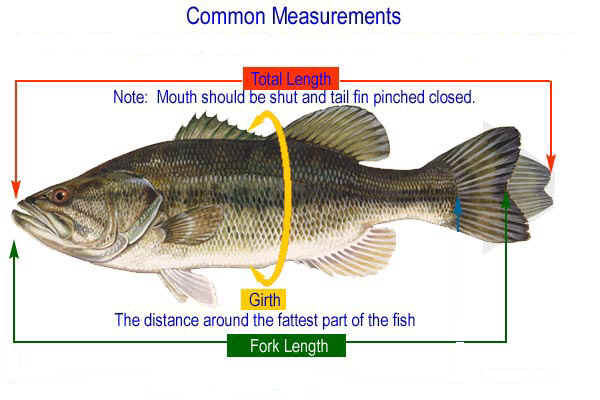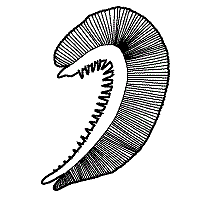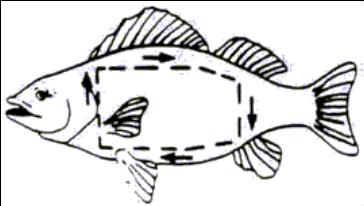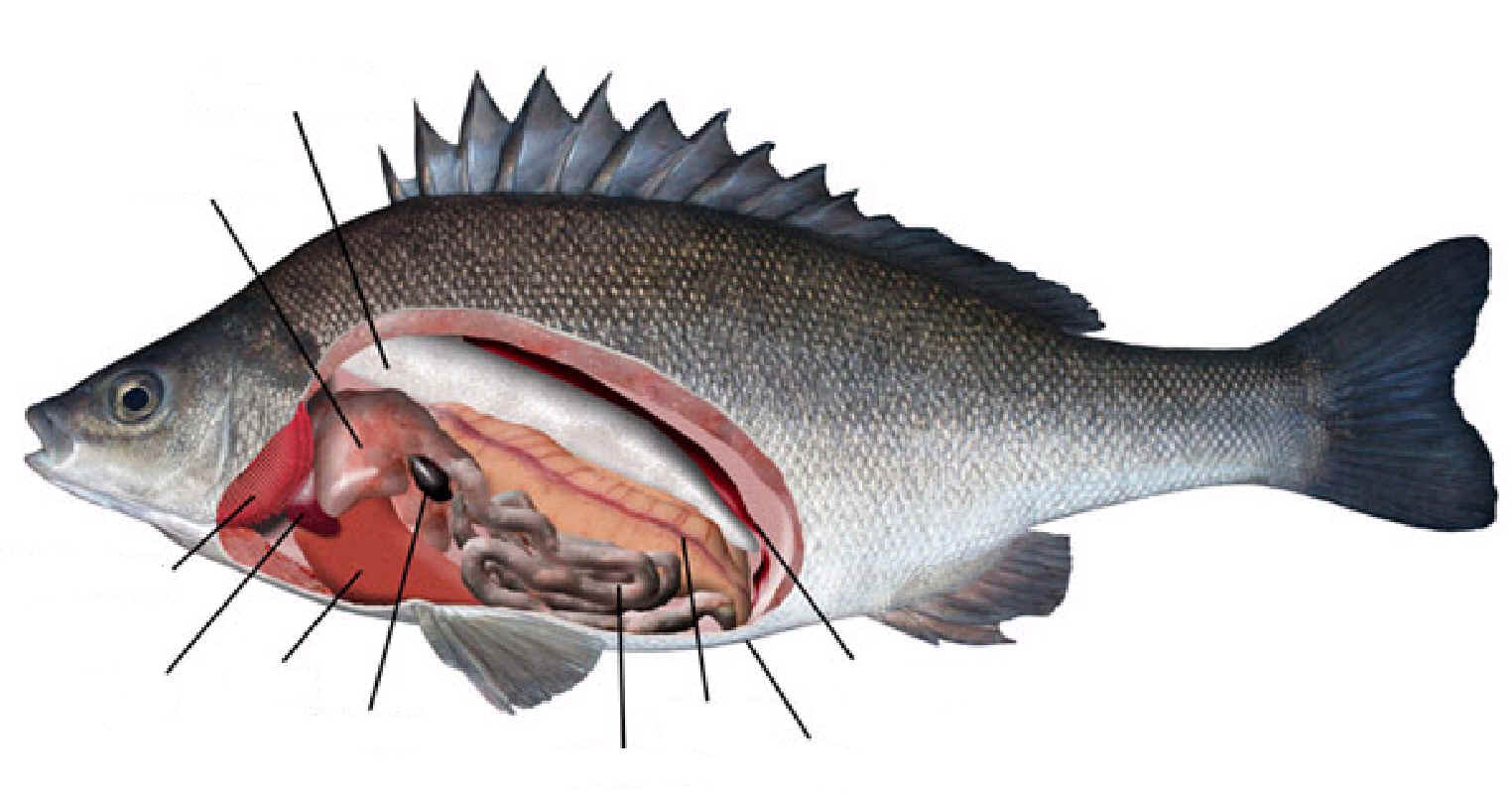| Perch Dissection |  |

Introduction:
The fish in the class Osteichthyes have bony skeletons. There are three groups of the bony fish — ray-finned fish, lobe-finned fish, and the lung fish. The perch is an example of a ray-finned fish. Its fins have spiny rays of cartilage &/or bone to support them. Fins help the perch to move quickly through the water and steer without rolling. The perch also has a streamline body shape that makes it well adapted for movement in the water. All ray-finned fish have a swim bladder that gives the fish buoyancy allowing them to sink or rise in the water. The swim bladder also regulates the concentration of gases in the blood of the fish. Perch have powerful jaws and strong teeth for catching and eating prey. Yellow perch are primarily bottom feeders with a slow deliberate bite. They eat almost anything, but prefer minnows, insect larvae, plankton, and worms. Perch move about in schools, often numbering in the hundreds.
The scientific name for the yellow perch, most often used in dissection, is Perca flavescens (Perca means “dusky”; flavescens means “becoming gold colored”). The sides of the yellow perch are golden yellow to brassy green with six to eight dark vertical saddles and a white to yellow belly. Yellow perch have many small teeth, but no large canines. Yellow perch spawn from mid-April to early May by depositing their eggs over vegetation or the water bottom, with no care given. The eggs are laid in large gelatinous adhesive masses.
![]()
Materials:
Preserved perch, dissecting pan, scalpel, scissors, forceps, magnifying glass, dissecting pins, apron, gloves, eye cover, tape measure
Procedure (External Anatomy):
- Obtain a perch & rinse off the excess preservative. Place the perch in your dissecting pan.
- Label the anterior, posterior, dorsal, and ventral sides of the perch on Figure 1.
- Use your tape measure to determine the total length, fork length, and girth of your fish. Record this in Table 1.

Table 1 – Fish Measurements (inches)
| Total Length | |
| Fork Length | |
| Girth |
- Locate the 3 body regions of the perch — head, trunk, and tail. Label these on Figure 1.
- Open the perch’s mouth and observe its bony jaws. Locate and label the upper jaw or maxilla and the lower jaw or mandible.
- Feel the inside of the mouth for the teeth. Locate & label the tongue & teeth on Figure 1.
- Open the mouth wider and use a probe to reach back to the gill chamber.
- Locate the nostrils and label on Figure 1.
- Locate and note the location of the eyes. Label on Figure 1.
- Find the bony covering on each side of the fish’s head called the operculum. The opercula cover & protect the gills. Label these on Figure 1.
Figure 1 – External Perch anatomy

- Use a probe to lift the operculum and observe the gills. Note their color.
- Use a scissors to cut away one operculum to view the gills. Find the gill slits or spaces between the gills.
- Use your scalpel to carefully cut out one gill. Find the cartilage support called the gill arch and the soft gill filaments that make up each gill. Label the parts of the gill in Figure 2.
Figure 2 – Gill Structure

- Observe the different fins on the perch. Locate the pectoral, dorsal, pelvic, anal, and caudal fins. Note whether the fin has spines. Label these on Figure 1 and complete Table 2 on fins.
Table 2 – Fins
| Name of Fin | Spines (yes or no) |
Number of Fins | Location | Function |
|
|
||||
|
|
||||
|
|
||||
|
|
||||
|
|
- Locate the anus on the perch anterior to the anal fin. In the female, the anus is in front of the genital pore, and the urinary pore is located behind the genital pore. The male has only one pore (urogenital pore) behind the anus. Determine the sex of your perch.
- Find the lateral line on the side of your perch. Label this line on Figure 1.
- Use forceps to remove a few scales from your fish. Observe the scales under the magnifying glass. Sketch a scale on Figure 3.
Figure 3 – Structure of a Scale
 |
- Count the growth rings on your scale to tell the age of your fish. (Hint: each ring represents one year’s growth.)
Procedure (Internal Anatomy):
- Use dissecting pins to secure the fish to the dissecting pan. Use scissors to make the cuts through skin and muscle shown in Figure 4.
Figure 4 – Cut Lines for Internal dissection

- After making the cuts, carefully lift off the flap of skin and muscle to expose the internal organs in the body cavity.
- Locate the cream colored liver in the front of the body cavity. Also locate the gall bladder between the lobes of the liver. Label these on Figure 5.
- Remove the gall bladder & liver to observe the short esophagus attached to the stomach. Label the stomach on Figure 5
- At the posterior end of the stomach are the coiled intestines. Locate and then label these on Figure 5.
- Find the small reddish brown spleen near the stomach and label this on Figure 5.
- Below the operculum, are the bony gill rakers. Locate these & them label them on Figure 5.
- In front of the liver & behind the gill rakers is the pericardial cavity containing the heart. The heart of a fish only has 2 chambers — an atrium & and a ventricle. Locate the heart & label it on Figure 5.
- In the upper part of the body below the lateral line is the swim bladder. This sac has a thin wall and gives the fish buoyancy. Label the swim bladder on Figure 5.
- Below the swim bladder are the gonads, testes or ovaries. In a female, these may be filled with eggs. Label the gonads on Figure 5.
- Find the 2 long, dark kidneys in the posterior end of the perch. These filter wastes from the blood. Label the kidneys in Figure 5.
- Wastes exit the body through the vent located on the ventral side of the perch. Label this structure on figure 5.
Figure 5 – Internal Perch Anatomy

Questions & Observations:
1. Are both jaws of the fish equally movable? Explain your answer.
2. Does the perch have eyelids?
3. How many gills are located on each side of the perch? What covering protects them?
4. What is the function of the gill rakers?
5. Explain how gas exchange occurs at the gills.
6. Which fin was the largest? What other difference do you notice in this fin when it was compared to the others?
7. What was the sex of your fish?
8. What is the function of the lateral line?
9. Describe how the scales are arranged on the trunk & tail of your fish.
10. Explain how the swim bladder controls buoyancy.

